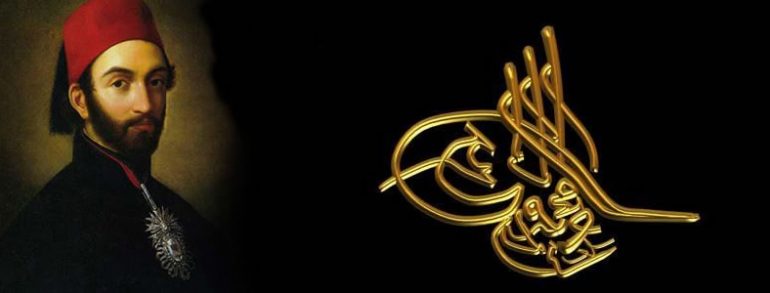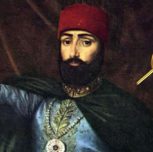(1823, 1839-1861)
Sultan Abdülmecid is remembered for the Dolmabahçe Palace, the pearl of the Bosphorus, but his achievements during the 38 years of his colorful life includes many wars, construction and modernization accomplishments, along with fathering a large family.
Sultan Mahmud II did not have any sons in the first 15 years of his reign to be enthroned after him. This created a big concern among the Ottoman elites. The birth of Abdülmecid on 25 April 1823 became a welcomed surprise to 38-year-old Mahmud II and Bezm-î Alem Valide Sultan (1807-1853), his wife.
Upon the death of Mahmud II on 1 July 1839 from tuberculosis at the age of 54, 16-year-old Abdülmecid found himself on the throne the next day as the 31st sultan. In order to honor his father, Sultan Abdülmecid built in 1840 a completely new mausoleum complex, the Mausoleum of Mahmud II (2. Mahmud Türbesi).
Bezm-î Alem Valide Sultan played a big role in the early period of Abdülmecid’s reign. Her successful involvement in governmental matters helped young and inexperienced Abdülmecid cope with serious state issues, and concealed her son’s weakness. Her philanthropist and merciful side helped them too.
The Ottoman Empire did not have any national anthem; instead, each sultan had personal marches to use as an anthem, which had been started by Sultan Mahmud II, his father. Italian-Ottoman Giuseppe Donizetti (1788-1856), who was the composer and the general instructor of the Imperial Band (Mızıka-yı Hümâyûn), was ordered to compose a march for the new sultan. Donizetti composed the “Mecidiye Marşı” in 1839. Abdülmecid later honored him with the title of Pasha.
Hans Christian Andersen (1805-1875), the Danish writer famous for his stories and fairy tales, visited Istanbul in 1842. He watched the public procession of Sultan Abdülmecid and his entourage.
Abdülmecid was the son of Mahmud II, who was one of the most reformist sultans in the Ottoman Empire. Being the first in line to the throne, he was specially trained well and believed the importance of the reforms. As a pro-European person, similar to his father, he tried to impose the European lifestyle in the Empire. He believed that new developments in Europe should be brought to the Empire to compete with Europeans and Russians, especially during the time when the Empire was seriously losing ground against them.
Hungarian composer and virtuoso pianist Franz Liszt (1811-1856) visited Istanbul in 1847, spending five weeks in the town. He amazed the Ottoman royal family with his fingers flying over the keyboard of the piano, when he gave two concerts in the old Çırağan Palace. Inspired by the Mecidiye Marşı, performed by the Ottoman Imperial Band, Liszt composed “Paraphrase for Sultan Abdülmecid”.
Young Abdülmecid was an active person. He traveled within the empire four times to get to know and speak to his people. He traveled for 17 days in 1844, 2 days in 1845, and 41 days in 1846. He also had a trip by boat in the southern Aegean Sea. During these trips, he talked to the local people, prayed with them, and learned their needs first hand. He also introduced his European garb and the concerts of the Imperial Band (Mızıka-yı Hümâyûn) to the public.
Tanzimât Era
Abdülmecid was young, but he was prepared for the throne. One of the first things Abdülmecid did in the early days of his reign was to sign the Letter of Tanzimât. The reorganization of the Ottoman Empire, called the Tanzimât, aimed to modernize the empire and the military, to integrate minorities into the society, to improve equality among the citizens, and to provide efficiency in bureaucracy. It started during the reign of Mahmud II, but it could not be finalized due to the death of Mahmud II. The Letter of Tanzimât, prepared by the bureaucrats led by Mustafa Reşit Pasha (1800-1856), the Foreign Minister, was presented to the public in the Gülhane Park of the Topkapi Palace on 3 November 1839, four months after Mahmud II died. Young Abdülmecid signed the letter, and abided by the terms during his reign. The period from 1839 until 1876, when the first constitution and parliament was introduced, is called the “Tanzimât Era”, which covers the entire reigns of Sultans Abdülmecid and Abdülaziz.
It was the time in the world when the political realities generated new ideas, which changed the direction of the political life. One of these ideas was introduced by Karl Marx (1818-1883), a German philosopher and economist. He published “The Communist Manifesto” in 1848.
Five years after the “Tanzimât Era” in 1844, the current Turkish Flag was formed and the eight-pointed white star on the red background was changed to five points.
His Monuments
The forest, named Kazancıoğlu Bahçesi in Beşiktaş (today, it includes the Çırağan Palace and the Yıldız Palace), was becoming quite popular within the imperial family. The sultans from Ahmed III (1703-1730) on including Mahmud II started to build summer pavilions there. Abdülmecid continued to do the same thing. He developed the area and built in 1842 a new pavilion complex, called Kasr-ı Dilküşa, for his mother.
This was the period of a construction boom. Therefore, Abdülmecid was affected by his contemporaries. He started to build a completely new palace complex in 1843 on the “filled-in garden”, called Dolmabahçe, located south of Çırağan. The new palace was built in the mixed architectural styles of Ottoman, Baroque, Rococo, and Neo-classic. The Dolmabahçe Palace was completed in 1856; 13 years after the construction had started.
Abdülmecid lost his mother, Bezm-î Alem Valide Sultan, in 3 May 1853 at the age of 48. The celebrated philanthropist Valide Sultan established many foundations (vakıf) and built modern Bezm-î Âlem Guraba Hospitals (Guraba Hastanesi) in 1845, schools (Dârülmaarif) in 1850, Dolmabahçe Mosque in 1855, many fountains and sebils. She also built the Galata Bridge (Cisr-i Cedit - Yeni Köprü) on the Golden Horn in 1845. Abdülmecid was very close to his mother. He buried her next to his father’s grave in the Mausoleum of Mahmud II (2. Mahmud Türbesi).
Abdülmecid extended the Selimiye Barracks in 1842 and 1853. During these extensions, seven-story towers were added on the corners of the gorgeous rectangular structure. The Barracks had burned down, and Sultan Mahmud II rebuilt it out of stone in 1828. The three-story structure is now one of the biggest structures in Istanbul.
The Crimean War (1853-1856)
The most important military confrontation at that time was the three-year Crimean War (1853-1856) between the Russians and the British, French, Sardinians and Ottomans. It marks the first Ottoman war, for which Ottomans allied with other countries. Among the major reasons of the war was that Russians desired to expand their territory south to the Ottoman land, and the British and French wanted to stop them. Allied soldiers came to Istanbul and settled in Selimiye Barracks then temporarily used it as a hospital.
The famous English nurse, Florence Nightingale (1820-1910), dubbed "The Lady with the Lamp", was invited to Istanbul to help the wounded British soldiers during the Crimean War. She arrived in November 1854 at Selimiye Barracks, which was temporarily used as an infirmary. Because of her personal initiative, the death rate among the wounded soldiers was reduced by 90%, which made her a national heroine in Britain. In 1954, to mark the centennial of her arrival in Selimiye, the Turkish Federation of Nurses converted Nightingale's rooms into the Florence Nightingale Museum.
In the Crimean War, one of the young artillery officers in imperial Russia’s military was Leo Tolstoy, a great Russian novelist, and the author of War and Peace (1869) and Anna Karenina (1877). Tolstoy described his experiences during the Siege of Sevastopol in “Sevastopol Sketches”.
The allied army defeated Russians and it became a victory for Abdülmecid too. After the war, the Ottoman Empire fell into a financial crisis. Because of the war, the Empire had to borrow from creditors for the first time in 1854. The growing demand for new loans after the war was beyond the capacity of the Galata Bankers (sarrafs or moneychangers). The Ottoman Bank, the first financial institution, was created in 1856 by a private British investment; later it became a British-French joint corporation.
Final Years
Abdülmecid wanted to rebuild Mahmud II‘s Çırağan Palace. He demolished the Palace in 1857, but he could not start the construction, as he could not finance the high cost of the new palace. Instead, in 1858 he built the Grand Pavilion (Mecidiye Köşkü), one of the latest additions to the Topkapi Palace complex.
After reigning about 22 years, Abdülmecid unexpectedly died at the age of 38 on 25 June 1861. Similar to his father, the cause of his death was tuberculosis. Upon his requirement, he was buried in the private mausoleum, built behind the Yavuz Sultan Selim Mosque.
During his short life, Abdülmecid left many unfinished projects, but he completed his most important project very well: to father children for the continuation of the Empire. Out of eight sons, four of them became the last sultans of the Ottoman Empire: Sultans Murad V, Abdülhamid II, Reşad and Vahidettin. He had 25 wives and 43 children. Sultan Abdülmecid‘s successor was his brother, Sultan Abdülaziz.
Emre Aracı, (2011), “Franz Liszt Istanbul’da”, Andante, Kasim, 2011.
Hans Christian Andersen, Knut Hamsun, (Çeviri: Banu Gürsaler Syvertsen), (2009), “İstanbul'da İki İskandinav Seyyah”, Yapı Kredi Yayınları, Istanbul.
Harun Korkmaz, (2011), “Sultan Abdülmecid döneminde Osmanlı müzik hayatı”, MOSTAR, Ekim, 2011, Sayi: 80.
Murat Bardakçı, (20 November 2011), Haberturk
Şerif Korkmaz, (2009), "Sultan Abdülmecid'in İlk Memleket Gezisi (26 Mayıs-12 Haziran 1844)", OTAM, Sayi 25. Ankara










